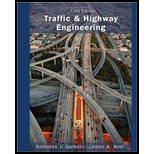
(a)
Average unit cost for operating a standard vehicle on a level roadway.
Answer to Problem 7P
Explanation of Solution
Calculation:
The average unit cost for operating a standard vehicle on a level roadway is as follows:
Let the depreciation cost per mile as
Let the registration and insurance cost per mile as
Let the maintenance cost per mile as
Let the fuel cost per mile as
The total cost required per mile by adding all the costs.
Total cost required per mile
Total cost required per mile
Conclusion:
Therefore, the average cost required for operating a standard vehicle on a level roadway is
(b)
Average unit cost for travel time for a truck.
Answer to Problem 7P
Explanation of Solution
Calculation:
The average unit cost for travel time for a truck.
Let the cost required per mile to operate the truck as
For the total unit costs using the relation
Substituting the values, we get
Substitute the value of
Let the average speed be
Substitute
Conclusion:
Therefore, the estimate average unit cost for travel time for a truck is
(c)
Average unit cost for single-vehicle property damage.
Answer to Problem 7P
Explanation of Solution
Calculation:
The average unit cost for single-vehicle property damage.
Substituting the values, we have
Conclusion:
Therefore, the average unit cost forsingle-vehicle property damage is
(d)
Average unit cost for personal injury.
Answer to Problem 7P
Explanation of Solution
Calculation:
The average unit cost for personal injury.
Let the cost for X-ray be equal to
Let the cost for emergency to be equal to
Conclusion:
Therefore, the average unit cost for personal injury is
(e)
The average unit cost for fatality.
Answer to Problem 7P
Explanation of Solution
Calculation:
The average unit cost for fatality.
It varies from $100,000 to $4.5 million.
Want to see more full solutions like this?
Chapter 13 Solutions
Traffic and Highway Engineering - With Mindtap
- PLease make sure to show all work and all steps for the image find the magnitude and stressesarrow_forwardShowing all work and steps find the magnituded and stress ,arrow_forwardWhat is the value of the influence line for the reaction at support A for the beam shown at 5 m to the right of A? Select the reaction at support B to be the redundant. a. 0 kN b. -0.167 kN c. 0.425 kN d. 1.0 kNarrow_forward
- Determine the force in member AB of the truss shown due to a temperature drop of 25°C in Members AB, BC, and CD and a temperature increase of 60°C in member EF. Use the method of consistent deformations. a. 37.34 k b. 0 k c. 28 k d. 46.67 karrow_forwardWhat is the approximate axial force in girder EF of the frame shown? Use the portal method. a. 32 kN b. 60 kN c. 12 kN d. 20kNarrow_forwardDetermine the vertical reaction at C for the beam shown and support settlements of 1" at B and ¼" at C. a. 27.0 k b. 28.3 k c. 43.7 k d. 21.0 karrow_forward
- What is the horizontal reaction component at D for the frame shown? a. 75.00 kN b. 91.67 kN c. 70.31 kN d. 4.69 kNarrow_forwardFind the vertical reaction at D for the frame shown and a settlement of 50 mm at support D. a. 80.7 kN b. 112.5 kN c. 144.3 kN d. 6.51 kNarrow_forwardDetermine if the W14x 22 beam will safely support a loading of w= 1.5 kip/ft. Theallowable bending stress is oallow = 22 ksi and the allowable shear stress is Tallow = 12 ksi.arrow_forward
- What is the fixed end moment FEMAB for the beam shown with a settlement of 1.2 in. at support B? a. -102.7 ft-k b. -95.2 ft-k c. -307.7 ft-k d. 279.8 ft-karrow_forwardSuggest an optimum footing size and shape (minimum area footing), if the vertical loading (includingthe weight of the footing) is 40 kips, and the soil has the following characteristics: c=200 psf, φ=370,and γ=120.0 lb/ft 3. Constraints of the solution are: the maximum dimension of any side of thefooting is 10 ft, and the depth of embedment is between 2 and 4 ft.arrow_forward15.6 A mountain stream flows over a rocky streambed. Apply the Limerinos and Chezy equations to calculate the discharge. The stream has an intermediate rock size d 84 of 30 cm, an average depth of 2.1 m, a slope of S = 0.0037, and a width of 52 m. In SI units, what is the discharge? a. 85, b. 120, c. 160, d. 240, or e. 410.arrow_forward
 Traffic and Highway EngineeringCivil EngineeringISBN:9781305156241Author:Garber, Nicholas J.Publisher:Cengage Learning
Traffic and Highway EngineeringCivil EngineeringISBN:9781305156241Author:Garber, Nicholas J.Publisher:Cengage Learning Solid Waste EngineeringCivil EngineeringISBN:9781305635203Author:Worrell, William A.Publisher:Cengage Learning,
Solid Waste EngineeringCivil EngineeringISBN:9781305635203Author:Worrell, William A.Publisher:Cengage Learning,

